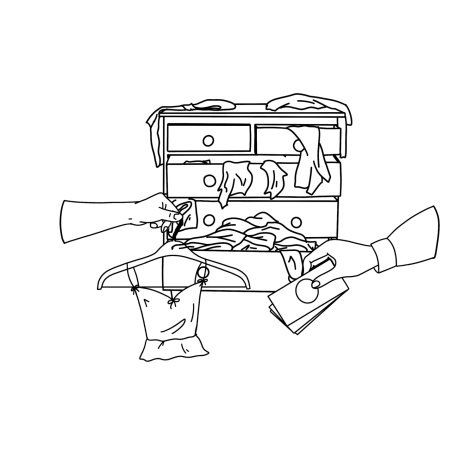Impact of fast fashion: Microtrends turn major
March 13, 2023
Meandering the halls of Redwood High School, one may notice recurring patterns in what teens are wearing. It’s easy to play into what’s popular, but when taking a step back and considering the larger timeline, it’s clear that these fads won’t last.
Microtrends are small, short-lived and often niche developments in consumer behavior. These trends can emerge and disappear quickly and are driven by social media and fast fashion companies. In 2020, Gen Z became hypnotized by apps such as TikTok as a distraction from the lockdowns and face masks, and during that time microtrends took over. With each swipe, one would see yet another Amazon corset, sweater vest, patchwork pair of jeans, psychedelic swirl or cow print. At the time, these pieces may have provoked people’s impulse to buy, with few realizing these trends would die, and they would die fast.

As a society, our habits of overconsumption have contributed to the mass production of clothing that have a trajectory of being neglected and thrown out. Avoiding the bandwagon of m
icrotrends and fast fashion brands pushed by social media and its influencers can lead to a more personalized wardrobe suitable for sustainability. Maybe then, Gen-Z won’t cycle through trends as fast as they can refresh their TikTok feed. Microtrends have taken over niche populations, but decline in popularity just as fast as they arose. According to Earth.org, an organization dedicated to Environmental News, Data Analysis, Research & Policy Solutions, clothing sales have doubled from 100 billion dollars per year in 2000, to 200 billion dollars per year by 2015. While money spent on clothing has skyrocketed, the average number of times an item was worn decreased by 36 percent overall. The whiplash of trends facilitate this increase in sales, coupled with the decrease in wear. These surges motivate responsive fast fashion brands to capitalize off of current trends with cheaply made clothing.
Maggie Zhou, author of the fashion journalism website Good On You, touched on the rise of microtrends and its relationship with fast fashion.
“The problem is that fast fashion brands fuel the feedback loop of these trends—quickly turning out cheap polyester versions to meet the newfound demand. That’s where microtrends raise ethical questions—and even some questions about our consumer psychology,” Zhou said.
Due to this quick-paced pendulum of “what’s in,” we find ourselves being submissive to these short-lived fads, purchasing poor quality pieces that contribute to our national overconsumption.
Not only are we negatively impacting the wellbeing of our planet, but indulging in these short-term fixations can hinder a teen’s personal growth. What a teen girl wears can determine her desires of either conforming to or rejecting her social community. In an article by Psychology Today, psychiatrist Dr. Brenda Berger explains a story of two friends who start to dress the same.
“By latching onto the same jeans, she was really seeking mirroring and external confirmation and supplies from her friend as a way to pump herself up, so she could feel more confident and less vulnerable,” Berger said.
Although not every teen has the same subconscious motives when picking out their outfits for the day, patterns among girls tend to suggest an intentional choice to match the same styles or pieces as their broader social community. This is seen as a security blanket, since being a teenager is challenging enough and the last thing one wants is to stand out. With the fabricated lives of everyone being plastered onto the internet, it can be easy for adolescents to compare themselves to other teens their age and pick apart what makes themselves different from the rest.
Although social media could potentially help teens discover what they like, what’s not seen behind the screen is the amount of money and manipulation that’s used to subliminally attract people into contributing to fast fashion. Generation Z looks up to influencers, yet those influencers are usually sponsored by advertisers who incentivize them to push certain products onto followers. Viral videos will appear on someone’s timeline or For You page, featuring video hauls of online shopping sprees from fast fashion brands such as Shein, Zara or Princess Polly, instigating a compulsory need of false necessities.
Deciphering what one actually likes, versus what one is told to like could make a big impact on the longevity of their clothing, allowing for more use out of their items. When society begins to recognize the negative effects of microtrends, fast fashion and social media on our earth and our personality development, we can hopefully all agree to accept a more sustainable lifestyle that benefits our people and the planet.























